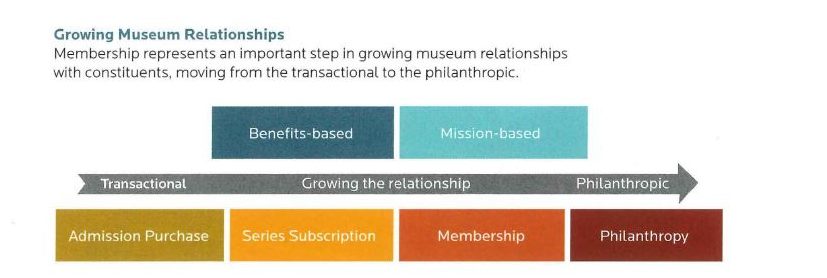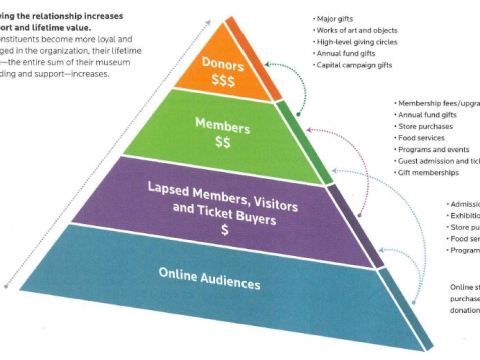
This article originally appeared in the November/December 2013 edition of Museum magazine.
Whether you’re working to reshape an existing membership program, starting a new one or breaking the traditional business model to invent something novel, the process begins with a research-based understanding of what your current members and membership prospects value and establishing the objectives and priorities for your organization.
Objectives for a membership program typically involve growing the base or member household count, deepening relationships through engaging programs and communications, maximizing long-term net revenue and strengthening loyalty. Within these broad objectives, museums will set different priorities influenced by unique financial, marketplace, fundraising, operational and other museum-specific factors. Museums often need to make trade-offs between growing the member count and maximizing short-term net revenue. While acquisition marketing can seem expensive, it’s a required investment for a healthy membership program designed and managed to deliver maximum return over the long haul.
Regardless of a museum’s priorities, membership represents an important step in an organization’s relationship with its audiences, one in which visitors and ticket buyers look beyond a single transaction and buy into a year-long experience with an expectation of visiting regularly and supporting a mission and organization they care about. Beyond the important earned income it delivers, a membership program also provides a critical source of donor prospects and contributed income, from annual fund gifts to planned giving and campaign support. The image opposite illustrates the nature of these different constituent relationships from the transactional to the philanthropic.
Research What Members and Prospects Value
Using both qualitative and quantitative research methods, as well as in-depth analysis of performance metrics, to understand member and nonmember motivations, behaviors and expectations is an essential starting point. Understanding what current members value, which benefits they actively use, and what they’ll pay more for are important pieces of the research and analysis puzzle. In addition, knowing what will attract nonmembers into a member relationship with the museum based on research and analysis is critical for attracting new members and expanding the base.
Research will also help in the identification of risky changes to the program structure, such as eliminating or moving benefits in a way that lowers member retention or encourages downgrades in membership level. The majority of members will typically belong at the lower-priced membership levels, often referred to as the general or introductory categories. With some 60-80 percent of member households at these levels, small changes to benefits and prices can have a significant impact on overall membership program revenue. Correctly anticipating response to such changes is crucial.
Design the Structure to Grow the Base
A museum’s ideal membership program will offer the right number of categories, with each category packaged with the right benefits and price to attract new members and encourage current members to upgrade to higher levels of participation. Museums often err on the side of offering too many membership categories, benefits, and choices, making the purchase or upgrade decision overwhelming. Avoiding overly complex structures that often turn people away, museums should work to simplify the membership purchase decision.
Structuring a membership program for growth in the member household count requires entry-level categories packed with valued benefits and priced right when compared to the cost of admission and tickets. A museum offering free general admission needs to make a compelling case for support and offer benefits that provide special access, such as exhibition previews and insider’s magazines or newsletters.
The most effective membership programs use all available marketing and sales tools to promote membership and its benefits. A multichannel marketing approach to acquiring and retaining members involves the whole gamut of direct marketing tools (direct mail, telemarketing, e-marketing, etc.), plus onsite sales and messaging in advertising and social media. Essentially the benefits of membership should be communicated throughout the museum experience; before, during and after a museum visit.
A roster of special exhibitions with “blockbuster” appeal, a new building or gallery opening, a significant anniversary or exclusive programs provide tremendous value for membership prospects and an ideal time for museums to make additional investments in growing the membership base. Museums typically ratchet up their acquisition marketing and sales efforts when such special opportunities are planned, as they increase the value of membership for broader audiences.
Sustain and Deepen Constituent Relationships
After attracting and welcoming new members into the membership community, the focus shifts from the work of acquisition marketing to relationship building, retention, and upgrades. The job of retention starts on day one of the relationship and requires a museum-wide commitment to delivering an exceptional museum and membership experience onsite, online, over the phone and through new media. Responsive service teams, regular and informative communication, and ongoing programming that encourages involvement and frequent museum visits will foster loyalty and growth in the relationship.
Communication efforts should be layered with messaging about how additional gifts of support and membership upgrades will further the museum’s mission and also provide new ways for members to become more engaged in museum activities. Inviting and moving members from general levels to mid-level categories and high-level donor circles will increase the overall return.
Maximize Long-Term Return and Lifetime Value of Constituents
Maximizing the long-term growth and net revenue from a membership program requires committed investments in acquisition and lapsed member recapture, strategic and robust retention efforts, effective upgrade programs and ongoing appeals for additional support. Museums need to balance the cost of delivering specific benefits and customized offerings with their ability to attract new members and achieve upgrades from current members.
The most productive and cost-effective investment will be in retention, followed by lapsed member recapture. The lifetime value of a recaptured lapsed member will exceed that of a new member and deliver return more quickly. That said, there will always be churn, and museums must make ongoing investments in member acquisition to fill the gaps left by those who don’t renew, but most importantly to grow the base and program revenue over time.
Strengthen Loyalty for Long-Term Success
Membership programs engage a community of individuals who have stepped forward to become involved in a museum’s activities and mission in a deeper way. Each member may be seeking a unique bundle of experiences; from solo time to social outing, educational enrichment to entertainment, or a deal on multiple visits to a philanthropic need to give back. Fortunately, the use of technology has made it easier and less expensive for museums to manage and support customized relationships with all constituents; from online and onsite visitors to members and donors.
The work of strengthening constituent loyalty is central to maximizing return from both earned and contributed income sources on a museum-wide scale. Members represent a committed community of individuals who want to belong and become engaged ·and support the organization. They have raised their hand to say they’re in, beyond a single visit or transaction. The museum’s job is to deliver on the promise of value with an exceptional membership experience. A healthy, growing and loyal membership base provides an essential pipeline for philanthropic support and demonstrates organizational strength to the board, funders, and community.
Suzette A. Sherman is a 17-year museum membership, marketing, and fundraising professional and is now an independent consultant in Washington, DC.










Comments